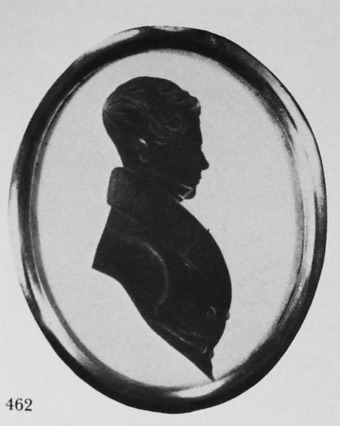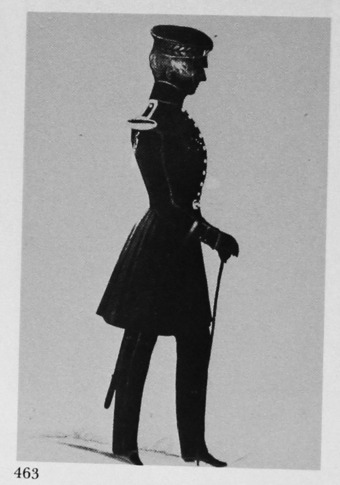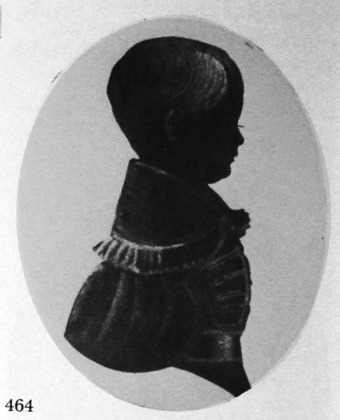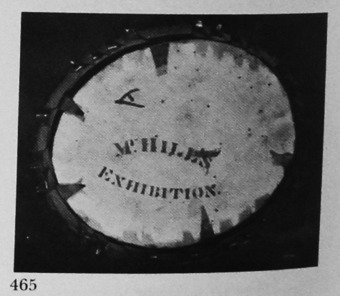- A
- B
- C
- D
- E
- F
- G
- H
- Haines, Edward
- Hallam, John
- Hamlet, William, the Elder
- Hamlet, William, the Younger
- Hancock, Robert
- Hanks
- Harding
- Hargraves
- Harraden, Richard Bankes
- Harrington, Sarah, Mrs
- Harris, John
- Hart, E.
- Hervé, Alfred, Count de la Monniere
- Hervé, Charles II
- Hervé, Henry I
- Hervé, Henry II
- Hill's Gallery
- Hill, I. or J.
- Hills
- Hine, H. J. C.
- Holden, H. W.
- Holland, William Langford
- Holmes, James, the Elder
- Horsefall, Marius
- Houghton and Bruce
- Houghton, Samuel
- Howie, James
- Howie, James G.
- Hubard Gallery
- Hubard, William James
- Hudson, C. H.
- Hudson, Elizabeth, Mrs
- Hunter, Thomas
- Hutchinson, J.
- J
- K
- L
- M
- N
- O
- P
- R
- S
- T
- V
- W
Hill's Gallery (McKechnie Section 1)
Known from three surviving profiles: one signed ‘Hill's Gallery’; a second backed with a stencil reading, ‘Mr Hill's Exhibition’; and a third inscribed on the reverse ‘Hill's Gallery of Art, Canterbury, 1835’. From the similarity of these three profiles in style, and the closeness of their likely dates, one can assume that they emanated from the same concern. Jackson recorded in her Dictionary a mid-nineteenth-century artist named Hills, who worked in Cambridge, but there is no evidence to connect Hills with Hill's Gallery. The artist named Hill (probably J. Hill) discussed in Sections Two and Seven was working earlier than the probable period of Hill's Gallery, and seems unlikely to have been connected with it. The gallery was probably a travelling concern, and it cannot be said with certainty that Hill himself was responsible for the work produced; he may simply have managed the concern and employed artists to take the silhouettes.
The silhouette backed with the stencil of ‘Mr. Hill's Exhibition’ is bust-length, and appears to date from the 1830s. The silhouette signed ‘Hill's Gallery’ is full-length, and also appears to date from the 1830s. Both sitters are men. Both silhouettes are cut from black paper and are sparsely but effectively embellished with gold paint. The bust-length profile is interesting for the termination: a long, sloping line often seen on work of the 1830s, marked by an indentation near the junction of the arm with the rest of the profile. The full-length profile (of a soldier in undress uniform) is slightly more competent in execution. The gold is of a rather strong yellow shade. The signature, near the subject's foot, is inscribed with a brush. The third silhouette, taken in Canterbury in 1835, is of a small boy wearing a Petersham coat; the work is similar to that on the bust-length example already described. 462 463
Ills. 462-465

462
Unknown man
Cut silhouette
1830s
3¼ x 2½in./83 x 64mm.
Stencil (‘Mr Hill’s Exhibition’)
Frame: papier mâché
Unknown man
Cut silhouette
1830s
3¼ x 2½in./83 x 64mm.
Stencil (‘Mr Hill’s Exhibition’)
Frame: papier mâché
W. E. Fox-Smith collection

463
Soldier of the 16th Foot (Bedfordshire and Hertfordshire Regiment)
Cut silhouette
1830s
9½ x 7in./242 x 178mm.
Frame: giltwood, with leaf and beading decoration
Inscribed ‘Hill’s Gallery’.
Soldier of the 16th Foot (Bedfordshire and Hertfordshire Regiment)
Cut silhouette
1830s
9½ x 7in./242 x 178mm.
Frame: giltwood, with leaf and beading decoration
The sitter is wearing undress uniform.
Inscribed ‘Hill’s Gallery’.
J. A. Pollak collection

464
Unknown boy
Cut silhouette, embellished with gold
1835
2 7/8 x 2 3/8 in./74 x 61mm.
Frame: papier mâché
Unknown boy
Cut silhouette, embellished with gold
1835
2 7/8 x 2 3/8 in./74 x 61mm.
Frame: papier mâché
Inscribed on the reverse, ‘Hill’s Gallery of Art, Canterbury, 1835’.
Author’s collection

465
Stencil of ‘Mr. Hill’s Exhibition’ (which can safety be identified with Hill’s Gallery), from the reverse of the silhouette shown in 462.
Stencil of ‘Mr. Hill’s Exhibition’ (which can safety be identified with Hill’s Gallery), from the reverse of the silhouette shown in 462.
W. E. Fox-Smith collection
